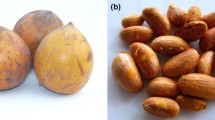Abstract
The nutrient composition, ofColocasia esculenta flowers (CF) and leaves (CL), and the green fruits ofSolanum melongena (SM) were carried out as a means to determine their nutritional potential. Results showed that these food materials had high moisture and fiber levels which ranged between 888 and 906 g·kg−1; and 204 and 303 g·kg−1 dry weight (dw) for moisture and fiber respectively. The calorific values were between 3889 and 4001 kcals·kg−1 dw, while the total lipids ranged from 53 in CF to 71 g·kg−1 dw in SM. The leaves ofColocasia esculenta had the highest crude protein value of 307 g·kg−1 dw. The flowers had 149 g·kg−1 dw while SM had 138 g·kg−1 dw. The amino acid profile in the flowers and leaves ofColocasia esculenta in contrast to SM were balanced comparable to the reference FAO pattern. Ash values were high (ranging from 76 in SM to 98 g·kg−1 in CL) with potassium being the principal element. Iron and Zinc levels were also high especially in CF (with 303 and 82 mg·kg−1 dw respectively). These foods also contained moderate quantities of calcium, phosphorus and magnesium but were poor in manganese and copper.
Similar content being viewed by others

References
National Academy of Science (1975) Unexploited tropical plants with promising economic value. Report of Ad hoc Panel of the Advisory Committee on Technology Inovations, Washington DC.
National Academy of Science (1978) Tropical legumes resources for the future. Report of Ad hoc Panel of the Advisory Committee on Technology Inovations. Washington DC.
Gurney JM (1975) Nutritional considerations concerning the staple foods of the English speaking Carribeans. Ecol Food Nutr 4: 171–179.
Will RBH, Lim JSK, Greefiled H, Bayliss-Smith (1993) Nutrient composition of taro (Colocasia esculenta) cultivars from the Papan New Quinea Highlands. J Sci Food Agric 34 (10): 1137–1142.
Treche S (1983) Evolution des différentes fractions azoté au cours de la maturité et de la conservation des tubercules d'Ignames. Incidence nutritionnelle. Revue Sc et Techn (Sci Santé), 4–5, 63–75.
Pomeran Z (1971) Food analysis: Theory and practice. Westport, CT: AVI.
AOAC (1984) Official Methods of Analysis of the Association of Official Analytical Chemists. 14th ed. Washington DC.
Van Soest PJ, Wine RH (1967) Use of detergents in the determination of fibrous feeds, 4. Determination of plant cell wall constituents. J Assoc Off Anal Chem 50: 5–55.
AOAC (1970) Official Methods of Analysis of the Association of Official Analytical Chemist. 11th ed. Washington DC.
Blackburn S (1968) Amino acid determination: Methods and technics. London: Edward Arnold, pp 119–137.
S.A.S. (1985) Users guide Statistics by Cary NC; Statistical Analysis System (S.A.S.) Institute Inc.
FAO (1973) Energy and protein requirements. Report of Joint FAO/WHO Ad hoc Expert Committee. Rome, 22 March to 2 April 1971. FAO Nutrition Meeting Report Series, No. 52.
Fokou E, Domngang F (1987) Etudes de Potentialité Nutritionnelles des quelques légumes feuilles consomés au Cameroun (2): Evaluation de fraction protidique. Ann Fac Sc Biol-Biochim 1 (4): 97–110.
Tremolière J, Cladian J, Serville Y (1984) Les groupes d'aliments in manuel d'élémentation humaine cord. Tremolière J, Serville Y, Jacques Rand Dupinheds Esf Paris T2. 19–35.
Gerloff ED, Lima, IH, Stohmann MA (1965) Leaf protein as food stuffs: Amino acid composition of leaf protein concentrate. J Agric Food Chem 13: 139–142.
Ifon ET, Bassir O (1980) The nutritive values of some Nigerian green leafy vegetables. Part 3. Food Chem 5: 231–235.
Tombet D. (1983) Contribution à l'étude de plant légumes de Centre-Sud: Systématique et Biochimie. Thèse de Doctorat de l'Université de Yaoundé.
FAO (1968) Food Composition Table for use in Africa. Rome: FAO.
Bonken ONB (1991) Analysis of tasteless seeds ofDrysophylum albidum: Nutritional aspects. J Sc Food Agric 56: 345–349.
USDA (1985) Composition of foods. Human nutrition information service handbook 8: 111.
Kelsay JH (1981) Effect of dietary fiber on bowel functions and trace mineral balances of human subjects. Cereal Chem 5: 2.
Munro A, Bassir O (1969) Oxalates in Nigerian vegetables. W African J Biol Appl Chem 12: 14–18.
Taylor OA, Tefuga BC, Oyenuga VA (1986) Nutrient composition of five common leafy vegetables. National Workshop on Composition of Nigerian Foods. University of Ibadan 28 March–5 April 1986.
Author information
Authors and Affiliations
Rights and permissions
About this article
Cite this article
Ejoh, A.R., Mbiapo, F.T. & Fokou, E. Nutrient composition of the leaves and flowers ofColocasia esculenta and the fruits ofSolanum melongena . Plant Food Hum Nutr 49, 107–112 (1996). https://doi.org/10.1007/BF01091966
Received:
Accepted:
Issue Date:
DOI: https://doi.org/10.1007/BF01091966



